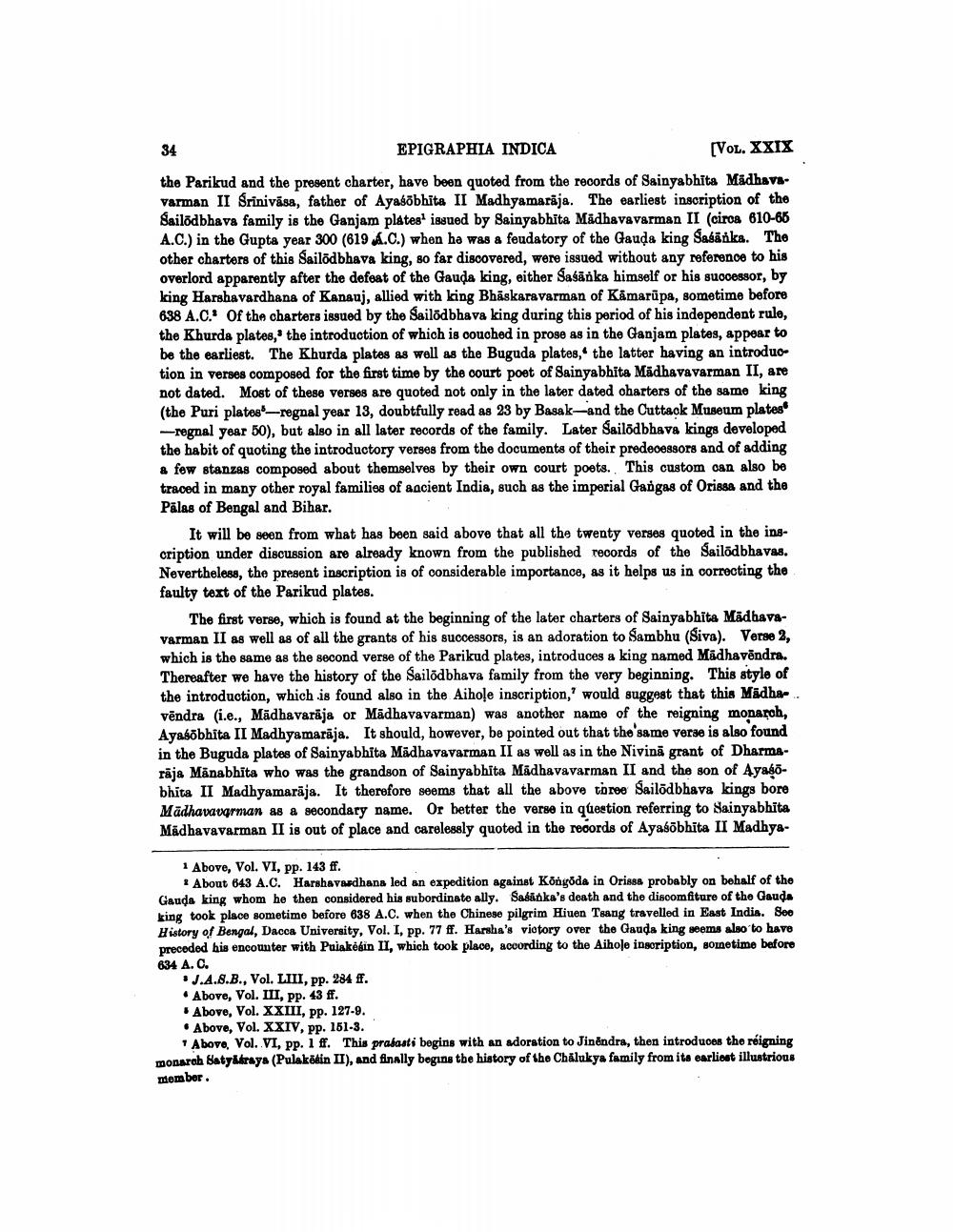________________
34
EPIGRAPHIA INDICA
[Vol. XXIX the Parikud and the present charter, have been quoted from the records of Sainyabhita Madhavsvarman II Srinivasa, father of Ayasõbhita II Madhyamaraja. The earliest inscription of the Sailodbhava family is the Ganjam plates issued by Sainyabhita Madhavavarman II (circa 610-65 A.C.) in the Gupta year 300 (619 A.C.) when he was a feudatory of the Gauda king Sasanka. The other charters of this Sailodbhava king, so far discovered, were issued without any reference to his overlord apparently after the defeat of the Gauda king, either Saśārka himself or his successor, by king Harshavardhana of Kanauj, allied with king Bhāskaravarman of Kämarūpa, sometime before 638 A.C. Of the charters issued by the Sailodbhava king during this period of his independent rule, the Khurda plates, the introduction of which is couched in prose as in the Ganjam plates, appear to be the earliest. The Khurda plates as well as the Buguda plates, the latter having an introduo tion in verses composed for the first time by the court poet of Sainyabhita Madhavavarman II, are not dated. Most of these verses are quoted not only in the later dated charters of the same king (the Puri plates-regnal year 13, doubtfully read as 23 by Basak- and the Cuttack Museum plates -regnal year 50), but also in all later records of the family. Later Sailodbhava kings developed the habit of quoting the introductory verses from the documents of their predecessors and of adding a few stanzas composed about themselves by their own court poets. This custom can also be traced in many other royal families of ancient India, such as the imperial Gangas of Orissa and the Pālas of Bengal and Bihar.
It will be seen from what has been said above that all the twenty verses quoted in the inscription under discussion are already known from the published records of the Sailodbhavas. Nevertheless, the present inscription is of considerable importance, as it helps us in correcting the faulty text of the Parikud plates.
The first verse, which is found at the beginning of the later charters of Sainyabhita Madhavavarman II as well as of all the grants of his successors, is an adoration to Sambhu (Siva). Verse 2, which is the same as the second verse of the Parikud plates, introduces a king named Madhavēndra. Thereafter we have the history of the Sailodbhava family from the very beginning. This style of the introduction, which is found also in the Aihoļe inscription,' would suggest that this Madhavēndra (i.e., Madhavarāja or Madhavavarman) was another name of the reigning monarch, Ayasobhita II Madhyamarāja. It should, however, be pointed out that the same verse is also found in the Buguda plates of Sainyabhita Madhavavarman II as well as in the Nivinä grant of Dharmaraja Mänabhita who was the grandson of Sainyabhita Madhavavarman II and the son of Ayasobhita II Madhyamarāja. It therefore seems that all the above three Sailodbhava kings bore Madhavavarman as a secondary name. Or better the verse in question referring to Sainyabbita Madhavavarman II is out of place and carelessly quoted in the records of Ayasobhita II Madhya
1 Above, Vol. VI, pp. 143 ff.
* About 643 A.C. Harshavardhana led an expedition against Kongoda in Orisss probably on behalf of the Gauda king whom he then considered his subordinate ally. Sasanka's death and the discomfiture of the Gauda king took place sometime before 638 A.C. when the Chinese pilgrim Hiuen Tsang travelled in East Indis. See History of Bengal, Dacca University, Vol. I, pp. 77 ff. Harsha's victory over the Gauda king seems also to have preceded his encounter with Puiakėsin II, which took place, according to the Aiholo insoription, sometime before 634 A.C.
• J.A.8.B., Vol. LIII, pp. 284 ff. . Above, Vol. III, pp. 43 ff.
Above, Vol. XXIII, pp. 127-9. • Above, Vol. XXIV, pp. 161-3.
Abovo, Vol. VI, pp. 1 ff. This prabasti begins with an adoration to Jinendra, then introduces the róigning monarch Batykraya (Pulakökin II), and finally begins the history of the Chalukya family from its earliest illustrious member




